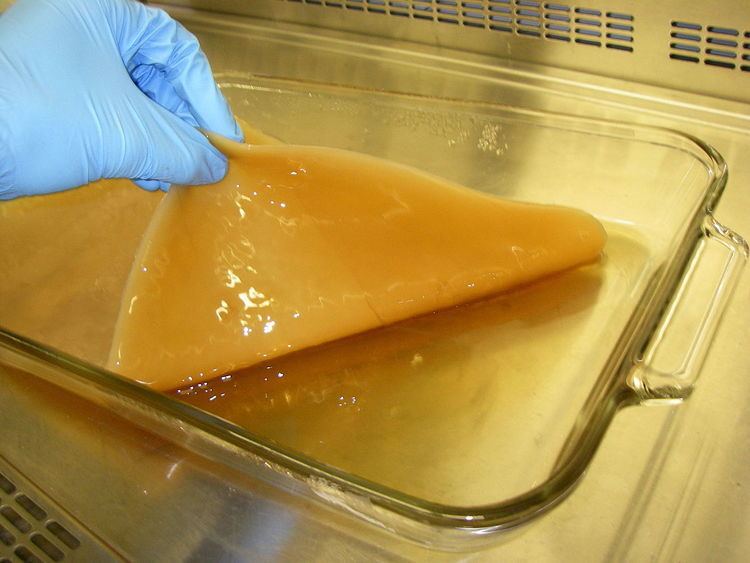 | ||
Microbial cellulose, sometimes called bacterial cellulose, is a form of cellulose that is produced by bacteria. It is widely used in the traditional Filipino dessert Nata de coco. The earliest articles describing microbial cellulose was from 1931, it was subsequently identified as cellulose in 1934.
Contents
Production
Bacteria from the genera Aerobacter, Acetobacter, Achromobacter, Agrobacterium, Alacaligenes, Azotobacter, Pseudomonas, Rhizobium, and Sarcina synthesize cellulose. However, only the Gluconacetobacter produce enough cellulose to justify commercial interest. The most extensively studied species is Gluconacetobacter xylinus, formerly known as Acetobacter xylinum and since reclassified as Komagataeibacter xylinus.
G. xylinus extrudes glycan chains from pores into the growth medium. These aggregate into microfibrils, which bundle to form microbial cellulose ribbons. Various kinds of sugars are used as substrate. Production occurs mostly at the interface of liquid and air.
Differences with plant cellulose
Some advantages of microbial cellulose over plant cellulose include:
Disadvantages for commercial use
Some issues that have prevented large-scale commercialization so far include:
Functions
One continuing mystery surrounding microbial cellulose is its exact biological function. A. xylinus, since been renamed as Gluconacetobacter xylinus and more recently as Komagataeibacter xylinus, is a successful and prevalent bacterium in nature, frequently finding a home in rotting fruits and sweetened liquids. The most familiar form of microbial cellulose is that of a pellicle on the top of a static cultured growth media. It has, thus, been hypothesized that cellulose acts as a flotation device, bringing the bacteria to the oxygen-rich air-media interface. This hypothesis has largely been discredited by experiments conducted on submerged oxygen-permeable silicone tubes that show that cellulose grows well submerged if enough oxygen is present. Others suspect that cellulose is used to immobilize the bacteria in an attempt to keep it near the food source, or as a form of protection against ultraviolet light.
Medical
Microbial cellulose is biocompatible and non-toxic, making it a good candidate material for medical applications. So far it has found a commercial role in some wound dressings. There is on-going research to evaluate a possible role for bacterial cellulose in the following applications:
